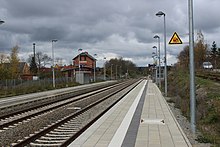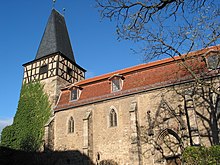Oberweimar (Thuringia)
|
Oberweimar
City of Weimar
Coordinates: 50 ° 57 ′ 56 ″ N , 11 ° 20 ′ 42 ″ E
|
|
|---|---|
| Height : | 215 m above sea level NN |
| Postal code : | 99425 |
| Area code : | 03643 |
|
Location of Oberweimar in Weimar
|
|
Oberweimar is a place in the southeast of the city of Weimar . Together with Ehringsdorf , it forms the Weimar district of Oberweimar-Ehringsdorf. Both suburbs of a village character were incorporated into the then state capital of the Free State of Thuringia in 1922. Oberweimar and Ehringsdorf together have almost 6,000 inhabitants (as of 2009).
geography
Oberweimar is located southeast of the core city of Weimar on the right side of the Ilm , traversed by the Papierbach . The park adjoins the Ilm to the northwest of Oberweimar .
history
It is an ancient settlement area on both sides of the Ilm. Since the beginning of the church organization in the 8th and 9th centuries there has been a settlement with a church. Count Hermann II of Weimar-Orlamünde founded a nunnery in 1244 . The surviving tombstone of Count Friedrich von Orlamünde (d. 1315) and Countess Elisabeth prove that the house monastery was intended as the burial place of the founding family. In 1244 the name Oberenwimare appeared for the first time . At that time, today's Weimar was sometimes referred to as Niederweimar . The church of St. Peter , which belongs to the monastery, was probably an important original parish for a long time and since the end of the 13th century the seat of an archpriest . By the time of the Reformation , 59 parishes are said to have belonged to his area. The monastery was given ample ownership of forests and lands. The last Counts of Orlamünde also gave the monastery, with their own jurisdiction, the towns of Oberweimar and Umpferstedt , and Ehringsdorf was added later. In 1350 an oil mill was put into operation in the monastery grounds. Although the monastery did not belong to this order, the nuns lived according to the Cistercian rule, later according to that of the Benedictine order. In 1372 Oberweimar became the property of Wettin .
The monastery was not destroyed in the German Peasants' War in 1525, but it was sequestered. The cloister courtyard was electoral chamber property of the Wettins. The monastery church was henceforth the evangelical parish church of the community. The monastery area formed the lordly office of Oberweimar , including Umpferstedt and Ehringsdorf . In 1546 the oil mill was converted into a paper mill . In 1613 the town was ravaged by the Thuringian Flood , and in 1639, during the Thirty Years' War , by the plague . In 1723 the stone bridge was built over the Ilm. Belvedere Palace was built in 1730 on the forest area of the former monastery . From 1793 the small brewery of the former monastery was assigned to the ducal model economy (the later Kammergut). In 1826 Carl Johann Christian Wilhelm Heydenreich (1795–1840) from Oberweimar acquired the local manor and continued to work as a brewing inspector for the Kammergut brewery. In 1876 the Weimar-Geraer Bahn was opened, and in 1897 Oberweimar received its train station . In 1900 Oberweimar had 2000 inhabitants. The company Elektroinstallation Oberweimar (EOW) was founded in 1907 (closed in 1992).
In 1922, together with Ehringsdorf, Oberweimar was incorporated into the city of Weimar. In 1925 the paper mill ceased operations. From 1932 to 1936 the Siedlersfreud settlement with 75 semi-detached houses for large families was built east of Oberweimar on the southern slope of the Ilm valley above the road to Taubach . In the extension of Bahnhofstraße there are also housing estates from this period. In April 1945 there was artillery fire on Oberweimar by the advancing US Army . In 1945 the land reform came with its expropriations, and a number of new farms were built. The manor house was demolished after 1945, as were the farm buildings that were still preserved. The property was added to the local LPG . In 1957 the bee museum moved into the country inn. 1973 to 1977 the new building area "Am Dichterweg" with prefabricated buildings was built northwest of the old Oberweimar. In 1990 the "Free Waldorf School " opened its doors in Oberweimar. In 1996 the Catholic parish church "Maria Queen of the Apostles" was consecrated by Erfurt Bishop Joachim Wanke .
Sights and culture
- The parish church of St. Peter and Paul has a lower part of the tower that dates back to the pre-monastic period as an original parish. The church was consecrated in 1281 as the monastery church of St. Peter and in 1291 as St. Peter and Paul. In 1362 a new church was completed, from 1516 to 1518 the tower was built with half-timbering. The water of the paper stream, which was previously used for baptism purposes, runs under the church.
- A monastery granary of the former chamber estate is adjacent to the church. Besides this, it is the only remaining building from the monastery period.
- The Waldorf School is located in the former monastery area.
- A stone bridge from 1723 leads over the Ilm.
- The German Bee Museum was set up in 1957 in some rooms of the historic country inn "Zum Goldenen Schwan" as the successor to the Beekeeping Museum from 1907 in the Weimar City Natural History Museum. This went back to a collection of the bee researcher Ferdinand Gerstung in Oßmannstedt . In 1973 the dilapidation of the country inn with the museum forced it to close. In 1985 Weimar beekeepers began renovating the inn and the surrounding area. In 1994 the German Bee Museum was able to reopen, in 2002 with a newly designed permanent exhibition. In 2003 the museum was closed by the city of Weimar for financial reasons and reopened in 2005 under the sponsorship of the Thuringian Beekeepers' Association in the German Beekeeping Association . There is a memorial stone for the Thuringian Flood in 1613 in the courtyard of the bee museum .
- Villa Haar, named after the founder Georg Haar (1887–1945), is located on the slope of the Ilmpark . Today it is used as a conference and event location. The lawyer and notary Georg Haar bequeathed it in June 1945 together with all his property to the city of Weimar as part of a foundation for war orphans to be established . In July 1945, after the Red Army marched into Weimar, Haar and his wife took their own lives.
Tourism
The Ilmtal cycle path leads through Oberweimar .
Personalities
- Lukardis von Oberweimar (* around 1274 probably in Erfurt; † March 22, 1309 in Oberweimar), nun, mystic, entered the Cistercian monastery in Oberweimar in 1286 and was later beatified
- Florentina von Oberweimar (* around 1506; † unknown), "nun against will" (from the noble family von Oberweimar) in the Helfta monastery
- Rudolf Zapfe (born July 24, 1860 in Oberweimar; † June 13, 1934 in Weimar), architect and building contractor in Weimar
- Georg Haar (born November 17, 1887 in Weimar; † July 22, 1945 in Weimar?), Lawyer and notary in Weimar, 1945 founder of the Haus Haar foundation for war orphans
- Hugo Hose (born September 10, 1890 in Oberweimar; † March 2, 1969 ibid), carpenter, trade union official, Thuringian state board member (SPD), city board member (SED) and 2nd chairman of the social security of the GDR
literature
- Oberweimar. In: Hans Patze , Peter Aufgebauer (Hrsg.): Handbook of the historical sites of Germany . Volume 9: Thuringia (= Kröner's pocket edition . Volume 313). 2nd, improved and supplemented edition. Kröner, Stuttgart 1989, ISBN 3-520-31302-2 , pp. 322-323.
Individual evidence
- ↑ a b Herbert von Hintzenstern : Built for eternity. Monastery complex in Thuringia. Cultural evidence from ancient times. VHT - Verlagshaus Thüringen, Erfurt 1996, ISBN 3-89683-104-6 , p. 49.
Web links
- Page about Oberweimar / Ehringsdorf on the homepage of the city of Weimar (via "About Weimar"> "Ortsteile")
- Private website about Oberweimar
- Website about the former Cistercian convent Oberweimar
- History of the Evangelical Lutheran Church of St. Peter and Paul in Oberweimar
- Website of the Oberweimar-Ehringsdorf district council








